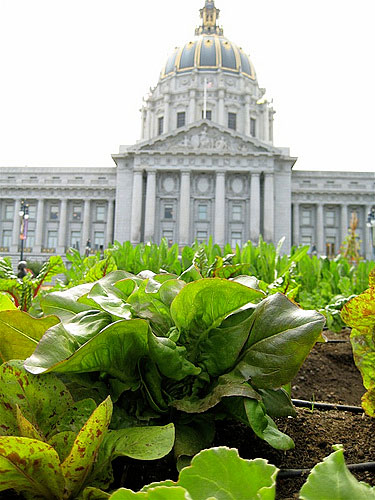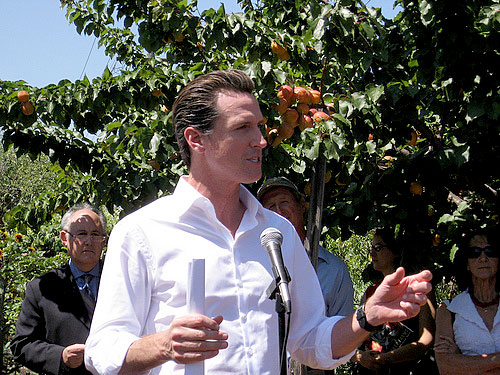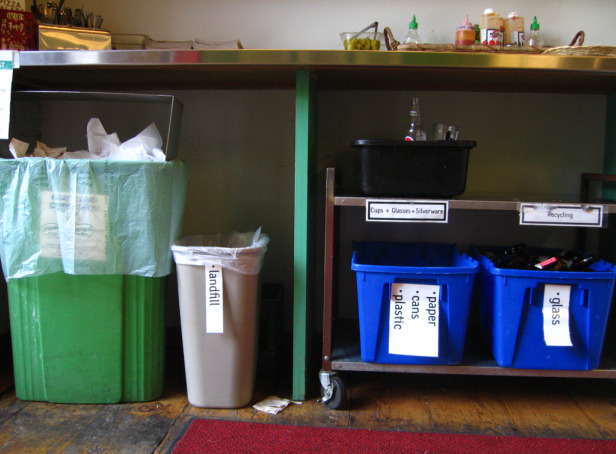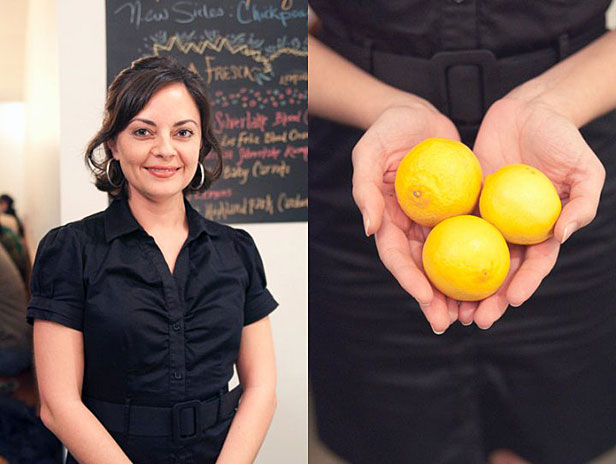 Grow for your supper: Forage patron and sometime supplier Sahir grows yellow limes in Loma Vista; the Los Angeles restaurant can now legally use ingredients such as hers in its dishes thanks to getting straight with the health department. Photo: Forage LA
Grow for your supper: Forage patron and sometime supplier Sahir grows yellow limes in Loma Vista; the Los Angeles restaurant can now legally use ingredients such as hers in its dishes thanks to getting straight with the health department. Photo: Forage LA
If some sort of natural disaster or terrorist attack were to shut down New York City’s food supply chain, our supermarket shelves would reportedly be picked clean within three days. Other U.S. cities aren’t any better prepared for such emergencies, thanks to our fuelish dependence on a globalized food system.
So my husband Matt keeps a bin filled with tins of sardines under the bed in our sardine tin-sized Manhattan apartment. Plus two cans of organic vegetarian chili, and a Kelp Krunch sesame energy bar. He’s on a self-sufficiency kick, too; makes his own vanilla extract, sauerkraut, duck rillette, and cat food. I guess we’ll be in pretty good shape if calamity comes a-callin’.
But how will our fellow New Yorkers feed themselves? Will they pluck purslane from the sidewalk cracks? Raid Annie Novak’s rooftop farm? Where will the freegans forage when the dumpsters are as empty as a Palin stump speech?
Matt and I aren’t the only ones stewing about our far-flung food chain. Evan Fraser, co-author of the new book Empires of Food: Feast, Famine, and the Rise and Fall of Civilizations, declared on NPR’s All Things Considered recently that our entire future is imperiled by a global food system “built on some very, very rickety pillars.”
 Lettuce lead the way: San Francisco planted a temporary Victory Garden in front of its city hall as part of 2008’s Slow Food Nation; the city has since enacted a regional food policy. Photo courtesy of In Praise of Sardines via FlickrFraser warns that the U.S. is making the same agricultural missteps that brought down the Roman and Mayan Empires: degrading our topsoil; banking blindly on ever-higher yields at a time when unstable weather patterns and depleted resources will more likely bring reduced harvests; cultivating a monoculture that’s economically efficient but ecologically ruinous. And talk about a vicious cycle — our fossil fuel-intensive, forest-and-ocean-destroying farming methods worsen climate change, which makes it ever harder to grow food all over the world.
Lettuce lead the way: San Francisco planted a temporary Victory Garden in front of its city hall as part of 2008’s Slow Food Nation; the city has since enacted a regional food policy. Photo courtesy of In Praise of Sardines via FlickrFraser warns that the U.S. is making the same agricultural missteps that brought down the Roman and Mayan Empires: degrading our topsoil; banking blindly on ever-higher yields at a time when unstable weather patterns and depleted resources will more likely bring reduced harvests; cultivating a monoculture that’s economically efficient but ecologically ruinous. And talk about a vicious cycle — our fossil fuel-intensive, forest-and-ocean-destroying farming methods worsen climate change, which makes it ever harder to grow food all over the world.
A relocalized food system, or “foodshed” (i.e., the path that our food travels to get from farm to plate) offers city dwellers a sustainable alternative to Agribizness-as-usual. Shorten your supply chain and you stand to reap a long list of benefits: increased food security; green space provided by urban farms and gardens; more fresh, wholesome foods and job opportunities where they’re needed most; less pollution and waste; and reinvigorated local economies.
A seismic shift toward greater self-sufficiency is rippling through every region. We’ve seen a dramatic rise in farmers markets and CSAs (community supported agriculture programs), and tremendous enthusiasm for community and school gardens and urban farms. Food policy councils are cropping up all over the country. From Sonoma to Chicago to Sheboygan, these coalitions have brought together policy makers, for-profit and non-profit enterprises, farmers, gardeners, and advocates to figure out how to go about relocalizing our food systems.
 Vine specimens: Forage Growers Circle member Warren shows off the bitter melon, cucumber, chard, and Japanese eggplant he grows in Highland Park for the restaurant. Photo: Forage LAThe first link in this brave new food chain? Land tenure, zoning issues, and other regulatory hurdles that city folks have to contend with in order to grow food to feed themselves or sell to others. They’re also working on how to collect and compost food waste instead of shipping it to the landfill; how to increase the percentage of locally sourced ingredients in schools, hospitals, prisons, and other publicly run institutions; how to facilitate local food production and ease distribution bottlenecks; and how to support all kinds of urban agriculture, from school and community gardens to rooftop farms, aquaculture, chicken keeping, and bee keeping.
Vine specimens: Forage Growers Circle member Warren shows off the bitter melon, cucumber, chard, and Japanese eggplant he grows in Highland Park for the restaurant. Photo: Forage LAThe first link in this brave new food chain? Land tenure, zoning issues, and other regulatory hurdles that city folks have to contend with in order to grow food to feed themselves or sell to others. They’re also working on how to collect and compost food waste instead of shipping it to the landfill; how to increase the percentage of locally sourced ingredients in schools, hospitals, prisons, and other publicly run institutions; how to facilitate local food production and ease distribution bottlenecks; and how to support all kinds of urban agriculture, from school and community gardens to rooftop farms, aquaculture, chicken keeping, and bee keeping.
Zoning in on vegging out
There’s no shortage of places to grow food in even the most densely built communities. What’s in short supply, in some cities, is better access to these spaces, and more secure tenure. With all the sweat equity that it takes to turn a barren lot or a rooftop into an edible oasis, our community gardeners and city farmers deserve to have their cherished plots protected from being plowed under to make way for more condos. Here in New York, hundreds of community gardeners and urban ag advocates turned out at a recent hearing to voice their concerns about proposed regulations that would sow uncertainty like a pernicious perennial weed in their carefully cultivated beds. Even now, despite a development-dampening recession and the resurgence of urban farming, community gardeners can’t afford to let down their guard.
Detroit has become an international poster child for urban agriculture, with an estimated 40 square miles or so of open land and a mayor, Dave Bing, who’s eager to convert those vacant lots into productive farms. But Detroit’s current zoning laws “neither define nor set standards for community gardening or commercial agriculture,” according to the city planning commission’s urban agriculture draft policy. So, Detroit’s thriving farms are off the radar, officially speaking. Mayor Bing is being encouraged to move “quickly to change the city and state legal structure to accommodate them,” as the Detroit News reports; Grist’s Tom Philpott has more on the history and future of Detroit’s urban-ag scene.
Seattle Mayor Mike McGinn has declared 2010 the “year of urban agriculture“, as Tyler Falk reported for Grist, and he means it: the c
ity government this month approved new legislation that allows any would-be urban farmer to grow and sell food, increases the number of backyard poultry allowed from three to eight, and other urban-ag-friendly moves.
In Los Angeles, Jason Kim, the young chef behind a hot new Silver Lake eatery named Forage, had the novel idea of letting home gardeners trade their surplus produce for meals at his restaurant. As the word spread, Kim’s “Home Growers Circle” grew to include more than a dozen backyard farmers.
But four months after he launched the program, Kim was obliged to suspend it after the health department informed him that produce from unlicensed growers would be a liability risk should a customer become ill.
After doing a little homework, the folks at Forage and the backyard farmers discovered that the Home Growers Circle could receive the same certification that lets professional farmers sell their produce at farmers markets, just by paying a $63 fee and undergoing an inspection. So, as of July, the Home Growers Circle is back in action, equipped with Certified Producer’s Certificates from the county agricultural commission that permit them to sell their backyard surplus to restaurants and markets.
Front-yard farmers in Sacramento, meanwhile, are just grateful they’re allowed to grow any food at all. It took food activists three years to overturn a ban on front yard food gardens that dated back to 1941. Now, they just have to get to work on Sacramento’s mayor, who left food out of the equation when he recently announced a “Green Initiative” to make his city more sustainable.
It’s an all-too-common oversight. Mayor Bloomberg — famous for championing a soda tax, salt reduction, and calorie counts — mysteriously ignored food when he announced New York City’s sustainability blueprint, PlaNYC. So, Manhattan Borough President Scott Stringer stepped up to the plate and collaborated with local good-food folks (disclosure: myself among them) to create FoodNYC, a comprehensive plan to relocalize New York City’s foodshed through such initiatives as an Urban Agriculture Program and an Office of Food and Markets. The FoodNYC team has met with the mayor to discuss incorporating their proposals into PlaNYC, but Bloomberg has yet to sign on.
 Friend o’locavores: Mayor Gavin Newsom announces a regional food policy for San Francisco.Photo courtesy of mayorgavinnewsom via FlickrSan Francisco Mayor Gavin Newsom needs no such prodding to put food policy front and center. In July, Newsom issued an executive directive which has the potential to “dramatically accelerate urban food production,” according to New School professor Nevin Cohen, an urban food policy expert who lauds Newsom’s specific mandates as a meaningful step up from the non-binding agreements and resolutions that typify so many food policy initiatives.
Friend o’locavores: Mayor Gavin Newsom announces a regional food policy for San Francisco.Photo courtesy of mayorgavinnewsom via FlickrSan Francisco Mayor Gavin Newsom needs no such prodding to put food policy front and center. In July, Newsom issued an executive directive which has the potential to “dramatically accelerate urban food production,” according to New School professor Nevin Cohen, an urban food policy expert who lauds Newsom’s specific mandates as a meaningful step up from the non-binding agreements and resolutions that typify so many food policy initiatives.
Newsom’s directive contains 16 mandatory actions that various agencies must take in the near future in order to implement its goals. Cohen cites several of the most significant:
- Within six months, every department with jurisdiction over property is required to audit the land under their control to identify sites suitable for food production
- All city agencies that purchase food for events or meetings must buy healthy, locally produced or sustainably certified foods to the maximum extent possible. Within two months, the Department of the Environment will draft a local and sustainable food procurement ordinance for City government food purchases.
- The Parks Department is directed to facilitate access to gardening materials and tools to support increased production of food within the City.
Food waste: kickin’ it to the curb
 Composter child: Portland, Ore. leads the way when it comes to keeping waste out of the landfill. Photo courtesy of kenudigit via Flickr
Composter child: Portland, Ore. leads the way when it comes to keeping waste out of the landfill. Photo courtesy of kenudigit via Flickr
We throw away an awful lot of perfectly edible food in this country, not to mention all those past-their-prime, slimy veggies and moldy bread. In fact, the food we discard each year wastes more energy than we extract annually from the oil and gas reserves off the nation’s coastlines, according to New Scientist.
Worse still, less than 3 percent of that food waste gets composted. The rest goes off to the landfill where it generates methane, a particularly potent greenhouse gas.
Wouldn’t you rather convert your kitchen scraps into ‘black gold’? As Darcy Minow Smith noted in Grist’s Composting 101 for Citydwellers, cities all over America are seeking to divert food waste from the landfill and feed it back to the earth instead.
San Francisco set the black gold standard last year when it passed a mandatory recycling and composting ordinance that requires every resident and business to sort their refuse into recyclables, compostables, and trash. The city composts more than 400 tons of food scraps and other organic matter each day.
Single-family households in Seattle are required to pay a monthly fee to have their food and yard waste picked up weekly, unless they opt to compost in their backyards. The city is currently contemplating extending this program to apartment and condo dwellers.
Portland, Ore. began weekly curbside recycling of kitchen waste last May in 2,000 households as part of a food-compost pilot program. If all goes well, the city plans to extend the program to all households, and switch to a biweekly schedule for regular garbage pickup, giving residents a greater incentive to recycle or compost as much of their waste as possible.
Clearly, the West Coast is on the carbon-cutting edge. But other cities have followed suit; Denver, Boulder, Austin, and Minneapolis all have curbside composting programs, some still in the pilot phase. The East Coast’s first municipal organic-waste pickup program began earlier this
year in the Massachusetts towns of Hamilton and Wenham. And as of July 1st, residents of Richmond, Va. are now permitted to add to their designated yard waste bins “anything that is from a plant, tree or animal that can decompose.”
Will San Francisco achieve its goal of becoming a zero waste city by 2020? Will other restaurants follow in Forage’s carbon foodprint and start sourcing their ingredients from neighborhood backyards? Our cities have only just begun to innovate, cultivate, and legislate their way to a more sustainable, locally-based food chain. No one’s seriously claiming that we’ll ever be able to produce all the food we need within our own boundaries.
In fact, skeptics dismiss the current urban mania for all things aggy — be it front-yard farming, backyard gleaning, rooftop gardening, keeping bees, chickens, worms, or canning your own kimchee — as some kind of homesteader-hipster hype. Agribiz apologists ascribe these trends to a plague they call “agrarian nostalgia,” which afflicts predominantly affluent, urban communities and seems to coincide with a high Pollan count.
Seeking self-reliance through sauerkraut may sound silly, but the drive to relocalize our food systems is an imperative, not a passing fad. We can’t even imagine what sorts of unforeseen disasters may be lurking — that’s why they’re called “unforeseen” — but do you really want to get caught with your pantry down?
I’m pretty resourceful when it comes to making a meal out of what’s on hand, but I’m not looking forward to Matt’s sardine/sauerkraut/cat-food patties seasoned with vanilla and topped with room-temperature chili. Better stock up on the kelp bars, just in case.



